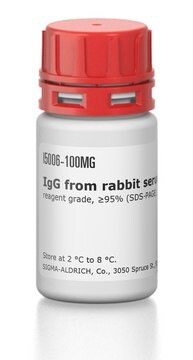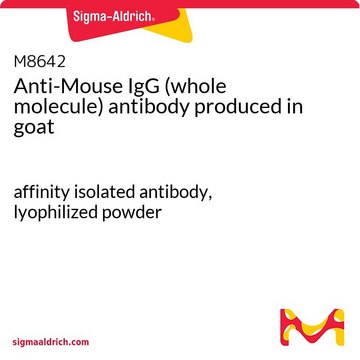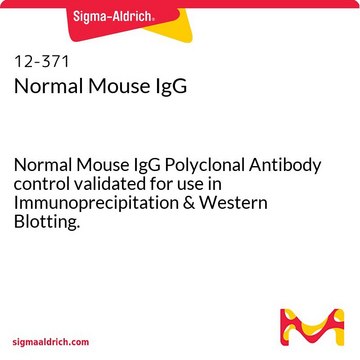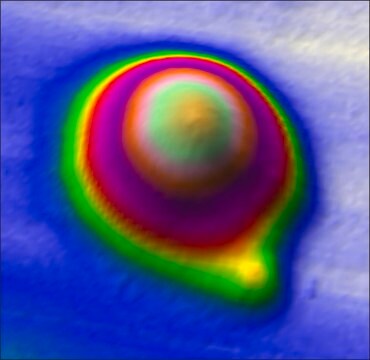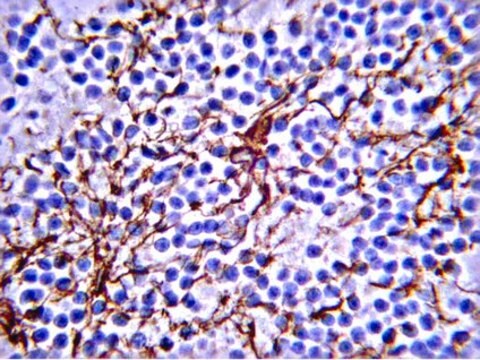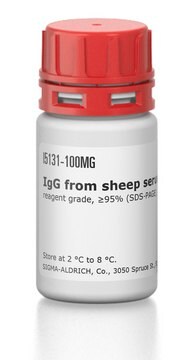I5381
IgG from mouse serum
reagent grade, ≥95% (SDS-PAGE), lyophilized powder
Sinonimo/i:
Mouse IgG
Autenticatiper visualizzare i prezzi riservati alla tua organizzazione & contrattuali
About This Item
Prodotti consigliati
Coniugato
unconjugated
Livello qualitativo
Grado
reagent grade
Saggio
≥95% (SDS-PAGE)
Forma fisica
lyophilized powder
Composizione
Protein, ≥80%
Temperatura di conservazione
2-8°C
modifica post-traduzionali bersaglio
unmodified
Cerchi prodotti simili? Visita Guida al confronto tra prodotti
Descrizione generale
IgG antibody subtype is the most abundant serum immunoglobulins of the immune system. It is secreted by B cells and is found in blood and extracellular fluids and provides protection from infections caused by bacteria, fungi and viruses. Maternal IgG is transferred to fetus through the placenta that is vital for immune defence of the neonate against infections
Mouse IgG is purified from normal mouse serum by fractionation and ion-exchange chromatography.
Mouse IgG is purified from normal mouse serum by fractionation and ion-exchange chromatography.
Applicazioni
Purified mouse IgG may be used as a reference antigen, standard, blocking agent, or coating protein in a variety of immunoassays including ELISA, dot immunobinding, Western immunoblotting, immunodiffusion, and immunoelectrophoresis. Other applications include starting materials for the preparation of immunogens and solid phase immunoadsorbents. Mouse IgG was used as standard in ELISA and chromatin immunoprecipitation assay. It was used to coat nano particles in the development of biosensors.
Stato fisico
Lyophilized from 0.01 M phosphate buffer, pH 7.2, with 0.015 M NaCl
Esclusione di responsabilità
Unless otherwise stated in our catalog or other company documentation accompanying the product(s), our products are intended for research use only and are not to be used for any other purpose, which includes but is not limited to, unauthorized commercial uses, in vitro diagnostic uses, ex vivo or in vivo therapeutic uses or any type of consumption or application to humans or animals.
Codice della classe di stoccaggio
11 - Combustible Solids
Classe di pericolosità dell'acqua (WGK)
WGK 3
Punto d’infiammabilità (°F)
Not applicable
Punto d’infiammabilità (°C)
Not applicable
Dispositivi di protezione individuale
Eyeshields, Gloves, type N95 (US)
Certificati d'analisi (COA)
Cerca il Certificati d'analisi (COA) digitando il numero di lotto/batch corrispondente. I numeri di lotto o di batch sono stampati sull'etichetta dei prodotti dopo la parola ‘Lotto’ o ‘Batch’.
Possiedi già questo prodotto?
I documenti relativi ai prodotti acquistati recentemente sono disponibili nell’Archivio dei documenti.
I clienti hanno visto anche
Bin Li et al.
International immunology, 19(7), 825-835 (2007-06-26)
We have found that FOXP3 is an oligomeric component of a large supramolecular complex. Certain FOXP3 mutants with single amino acid deletions in the leucine zipper domain of FOXP3 are associated with the X-linked autoimmunity-allergic dysregulation (XLAAD) and immunodysregulation, polyendocrinopathy
Fluorescent Biorecognition of Gold Nanoparticle-IgG Conjugates Self-Assembled on E-Beam Patterns
Powell T and Yoon JY
Biotechnol. Progress, 22, 106-110 (2006)
Lonnie J Lucas et al.
Biosensors & bioelectronics, 23(5), 675-681 (2007-09-18)
Double detection of microsphere light scattering and quantum dot emission was demonstrated for lab-on-a-chip immunoassay without using stationary support. We conjugated quantum dots (QDs) onto microspheres to enable multiplex assays as well as to enhance the limit of detection (LOD).
Panojot Bifsha et al.
Molecular neurobiology, 54(7), 4921-4935 (2016-08-16)
Dysfunction of midbrain dopaminergic (mDA) neurons is involved in Parkinson's disease (PD) and neuropsychiatric disorders. Pitx3 is expressed in mDA neuron subsets of the substantia nigra compacta (SNc) and of the ventral tegmental area (VTA) that are degeneration-sensitive in PD.
C Rebouissou et al.
Blood, 91(12), 4727-4737 (1998-06-17)
Agonist antihuman gp130 transducer monoclonal antibodies (MoAbs) were used in SCID mice to grow myeloma cells whose survival and proliferation is dependent on gp130 transducer activation. The agonist anti-gp130 MoAbs neither bound to murine gp130 nor activated murine cells and
Il team dei nostri ricercatori vanta grande esperienza in tutte le aree della ricerca quali Life Science, scienza dei materiali, sintesi chimica, cromatografia, discipline analitiche, ecc..
Contatta l'Assistenza Tecnica.
